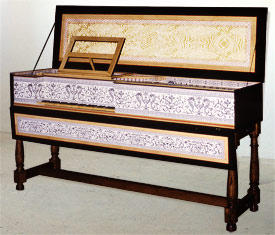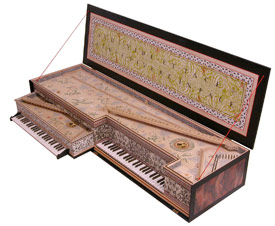'Mother'
and 'Child' after examples of the Ruckers
(Also available in kit form)
 Closed,
the Flemish virginal looks like nothing so much as an elongated linen
closet. Open, the visual effect is striking. The keyboard is surrounded
by decorative block printed papers of the sort the Ruckers would have
used. These papers also cover the front of the case and line the inside
of the fallboard as well as the case above the soundboard, and the interior
of the lid. The possibility of adding mottoes to the lid and fallboard,
and painting figures of flowers and birds on the soundboard should not
be overlooked. Although sober, even somber, with the lid down and the
fallboard up, the effect sought by the old makers was a riot of color
and detail when the instruments were open to be played.
Closed,
the Flemish virginal looks like nothing so much as an elongated linen
closet. Open, the visual effect is striking. The keyboard is surrounded
by decorative block printed papers of the sort the Ruckers would have
used. These papers also cover the front of the case and line the inside
of the fallboard as well as the case above the soundboard, and the interior
of the lid. The possibility of adding mottoes to the lid and fallboard,
and painting figures of flowers and birds on the soundboard should not
be overlooked. Although sober, even somber, with the lid down and the
fallboard up, the effect sought by the old makers was a riot of color
and detail when the instruments were open to be played.
 Flemish
virginals emerged in the 17th century as two distinct instruments depending
on which side of the front of the instrument the keyboard was located.
Those with keyboard positioned to the right were known as muselars
(above). These instruments, by plucking the strings close
to their center points, produced a round, fluty sound of unusual power.
The spinet, whose keyboard lies to the left of the center (left),
produces a sound approaching that of the wing-shaped harpsichord of
the period. (Sound samples.) Explained simply,
with the keyboard to the left, the spinet's jacks pluck the
strings at points similar to those that would have been found in an
instrument with a bentside.
Flemish
virginals emerged in the 17th century as two distinct instruments depending
on which side of the front of the instrument the keyboard was located.
Those with keyboard positioned to the right were known as muselars
(above). These instruments, by plucking the strings close
to their center points, produced a round, fluty sound of unusual power.
The spinet, whose keyboard lies to the left of the center (left),
produces a sound approaching that of the wing-shaped harpsichord of
the period. (Sound samples.) Explained simply,
with the keyboard to the left, the spinet's jacks pluck the
strings at points similar to those that would have been found in an
instrument with a bentside.
The
ottavino or "child" is a diminutive spinet virginal
whose construction generally parallels that of its larger relative.
The main difference lies in the fact that, rather than being recessed,
the keyboard of the ottavino projects between two scrolls from
one of the long sides of the virginal. It is made without a lid, has
a moulding of its own size that runs completely around the top of its
four straight sides, and is intended to be covered with block printed
papers all around.
 As
its name would imply, the ottavino is pitched one octave higher
than either the spinet or muselar or, in the parlance,
at four-foot pitch (photo,
below). It stores easily in the body of the large virginal, hence
the term from the old Flamands, "Mother and Child." It can
be played either by itself on a table, or, if placed atop the large
virginal from which the jack rail has been removed, it may be played
from the lower instrument's keyboard. In the latter case, one is playing
a double-manual virginal disposed 1 x 8', 1 x 4' on the lower manual
and 1 x 4' on the upper. The only manner of uncoupling the two instruments
is to lift the ottavino off its mother and replace the mother's
jack rail.
As
its name would imply, the ottavino is pitched one octave higher
than either the spinet or muselar or, in the parlance,
at four-foot pitch (photo,
below). It stores easily in the body of the large virginal, hence
the term from the old Flamands, "Mother and Child." It can
be played either by itself on a table, or, if placed atop the large
virginal from which the jack rail has been removed, it may be played
from the lower instrument's keyboard. In the latter case, one is playing
a double-manual virginal disposed 1 x 8', 1 x 4' on the lower manual
and 1 x 4' on the upper. The only manner of uncoupling the two instruments
is to lift the ottavino off its mother and replace the mother's
jack rail.
Flemish Virginals & Ottavino – Offering
Sheet
Listen
To Them...
You can hear excerpts from a demonstration
CD we have prepared for these instruments:
~
A Note About The Files ~
Not
all mp3 files are equal! The sound of a harpsichord is particularly
difficult to compress satisfactorily. The bit rate we have chosen
for these samples is the lowest that reproduces the original recording
with negligible loss. Download times will vary widely depending
on your setup and the quality of your connection. On a 28K
Internet connection, the shorter sound sample may take from about
5 to over 10 minutes to download. If you have a fast connection (T1,
cable modem, DSL) please try the long sample - you may expect download
times substantially under a minute.
~ Problems Playing the File ~
If you cannot play the file through your web browser, PC users with
the Microsoft browser can right click on the link, then choose the
"Save target" option to download the file, then use an MP3
player (or a the Windows media player) to listen to it.
We
now have available two demonstration CDs
of the Flemish Mother and Child virginals. The first, recorded
in analog stereo in 1982, documents both muselar
& spinet types. The second CD, recorded digitally in 2003,
is devoted solely to the Muselar.
(Each CD is $10.00 ppd. in U.S.). Please -inquire via our
contact form.

Ottavino (return
to text above)